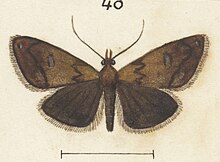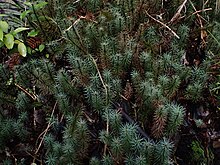| Glaucocharis epiphaea | |
|---|---|

| |
| Female | |
| Scientific classification | |
| Domain: | Eukaryota |
| Kingdom: | Animalia |
| Phylum: | Arthropoda |
| Class: | Insecta |
| Order: | Lepidoptera |
| Family: | Crambidae |
| Subfamily: | Crambinae |
| Tribe: | Diptychophorini |
| Genus: | Glaucocharis |
| Species: | G. epiphaea |
| Binomial name | |
| Glaucocharis epiphaea (Meyrick, 1885) | |
| Synonyms | |
| |
Glaucocharis epiphaea is a species of moth in the family Crambidae. It was described by Edward Meyrick in 1885. It is endemic to New Zealand and has been observed in both the North and South Islands. G. epiphaea prefers mountainous habitat and frequents very damp spots including alpine and subalpine moss bogs. Larvae feed on the moss Dawsonia superba. Adults are on the wing from September until March and are diurnal.
Taxonomy
This species was first described by Edward Meyrick in 1885 using specimens collected at Arthur's Pass in January and named Diptychophora epiphaea. George Hudson discussed and illustrated this species under that name in his 1928 book The butterflies and moths of New Zealand. In 1929 Alfred Philpott studied the male genitalia of this species. In 1971 David Gaskin placed this species in the genus Pareromene. In 1985 Gaskin again discussed this species and placed it in the genus Glaucocharis. The male lectotype is held at the Natural History Museum, London.
Description

Meyrick described this species as follows:
Male, female. — 12-14 mm. Head, palpi, antennae, thorax, abdomen, and legs fuscous. Forewings broad, triangular, costa hardly arched, apex rounded, hindmargin oblique, slightly rounded, once indented below apex; fuscous, with green reflections; lines slender, irregularly denticulate, dark fuscous; first line from beyond 1⁄3 of costa to before middle of inner margin, angulated above middle and bent inwards below middle; discal spot obsolete or represented by a faint darker suffusion; second line from 3⁄4 of costa to 3⁄4 of inner margin, angulated above middle, thence tolerably straight; sometimes two or three whitish longitudinal streaks towards hindmargin above middle; a small black apical spot : cilia whitish, with a shining dark grey basal and lighter median line. Hindwings grey or dark grey, with greenish reflections; cilia light grey, with a dark grey basal line.
Meyrick stated that G. epiphaea can be distinguished from the similar in appearance species G. bipunctella as G. epiphaea has less distinct markings and no white discal spot.
Distribution
This species is endemic to New Zealand and is found in both the North and South Islands.
Habitat and hosts

This species prefers mountainous habitat and can be found near or just above the upper limit of native forest and frequents very damp spots. It has been observed at the North Island central plateau and also in South island alpine and subalpine moss bogs. Larvae of G. epiphaea feed on the moss Dawsonia superba. As D. superba does not occur above the tree line in the mountains it has been hypothesised that the larvae of G. epiphaea does not exclusively feed on D. superba but has other hosts. Larvae have also been raised to maturity using Polytrichadelphus magellanicus as a supplementary food source.
Behaviour
Larvae feed from silk refuge tunnels covered in leaf fragments and frass. The adult moths are day flying and are on the wing from September until March.
References
- ^ "Glaucocharis epiphaea (Meyrick, 1885)". www.nzor.org.nz. Landcare Research New Zealand Ltd. Retrieved 20 January 2018.
- ^ Dugdale , J. S. (23 September 1988). "Lepidoptera - annotated catalogue, and keys to family-group taxa". Fauna of New Zealand. 14. Department of Scientific and Industrial Research: 144. doi:10.7931/J2/FNZ.14. ISSN 0111-5383. Wikidata Q45083134.
- Gordon, Dennis P., ed. (2010). New Zealand inventory of biodiversity: Kingdom animalia: chaetognatha, ecdysozoa, ichnofossils. Vol. 2. p. 457. ISBN 978-1-877257-93-3. OCLC 973607714. OL 25288394M. Wikidata Q45922947.
- Edward Meyrick (January 1885). "Description of New Zealand Microlepidoptera. V. Pyralidina". New Zealand Journal of Science. 2: 347. Wikidata Q115123797.
- ^ Edward Meyrick (May 1885). "Art. XII. — Descriptions of New Zealand Micro-Lepidoptera". Transactions and Proceedings of the New Zealand Institute. 17: 132. ISSN 1176-6158. Wikidata Q110063611.
- ^ Hudson, G. V. (1928), The butterflies and moths of New Zealand, Illustrator: George Hudson, Wellington: Ferguson and Osborn Limited, p. 176, LCCN 88133764, OCLC 25449322, Wikidata Q58593286
- Alfred Philpott (1929). "The male genitalia of the New Zealand Crambidae". Transactions and Proceedings of the New Zealand Institute. 60 (3): 491–514. ISSN 1176-6158. Wikidata Q124044081.
- ^ David Edward Gaskin (1971). "A revision of New Zealand Diptychophorini (Lepidoptera; Pyralidae; Crambinae)". New Zealand Journal of Science. 14: 776 - 777. ISSN 0028-8365. Wikidata Q110236267.
- ^ David E. Gaskin (20 December 1985). "Morphology and reclassification of the Australasian, Melanesian and Polynesian Glaucocharis Meyrick (Lepidoptera : Crambinae : Diptychophorini)". Australian Journal of Zoology. Supplementary Series. 33 (115): 1. doi:10.1071/AJZS115. ISSN 0310-9089. Wikidata Q54618937.
- ^ Glime, J. M. (2020). "Chapters 12-14". Bryophyte Ecology. Vol. 2 (published 19 July 2020). p. 10.
- ^ Beever, Jessica E.; Dugdale, J. S. (January 1994). "Bryological Notes: Bryophagy of Dawsonia superba Grev. by larvae of the crambid moth Glaucocharis epiphaea (Meyrick) in New Zealand". Journal of Bryology. 18 (2): 365–366. doi:10.1179/jbr.1994.18.2.365. ISSN 0373-6687.
| Taxon identifiers | |
|---|---|
| Glaucocharis epiphaea | |